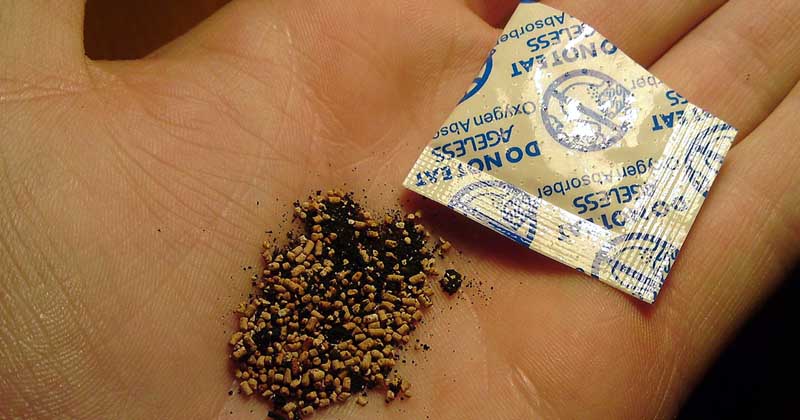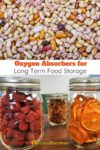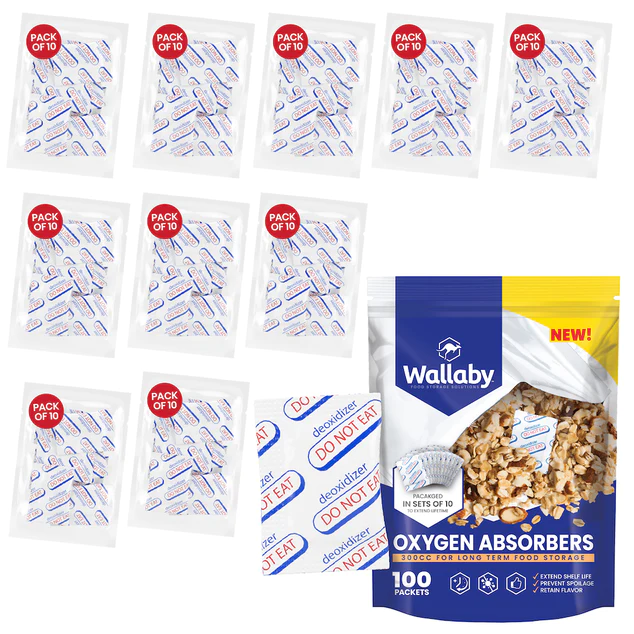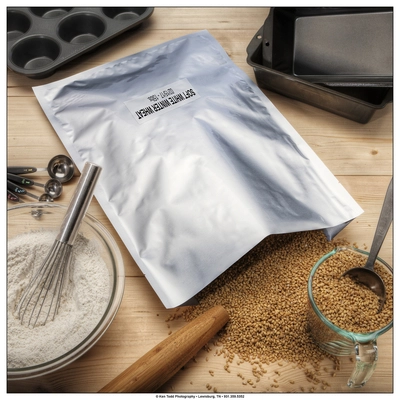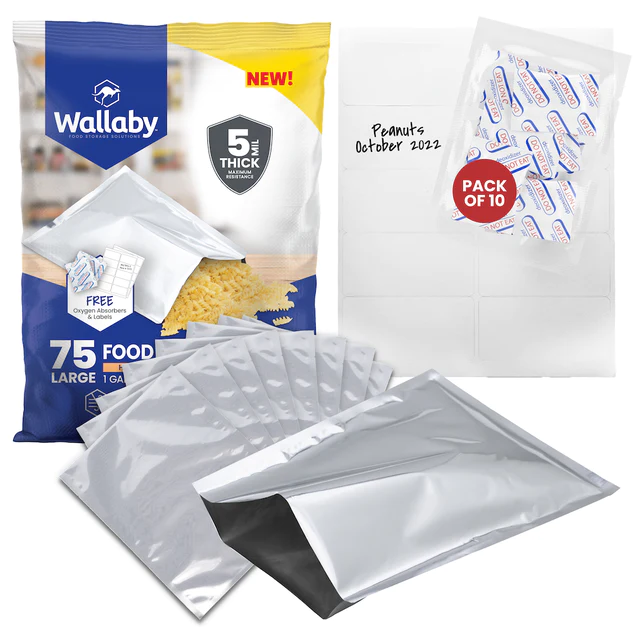[ad_1]
Even non-perishables like beans and rice will eventually become bad if exposed to oxygen. If you want to store food long-term, you’ll have to protect it from oxygen. Luckily, there’s a cheap and easy solution: oxygen absorber packets.
What Are Oxygen Absorbers?
Oxygen absorbers are little packages containing iron. When you put the oxygen absorber (OA) into an airtight container, the oxygen molecules “stick” to the iron. OAs can reduce the amount of oxygen in a container to less than 0.01%. (1)
Remember that air is about 78% nitrogen, 21% oxygen, and 1% other gases. Oxygen absorbers only remove the oxygen. However, nitrogen does not cause food to spoil.
Benefits of Using Oxygen Absorbers:
*See the section on botulism in the FAQs
How to Store Food with Oxygen Absorbers
To store food with oxygen absorbers, you will need to put the food and oxygen absorbers in an airtight container. If the container leaks air, it is pointless to use oxygen absorbers. There are four main containers that can be used for long-term food storage with oxygen absorbers.
1. Mylar Bags
Mylar is a metallic-looking material that doesn’t allow air or humidity through. Mylar bags are very cheap and durable, making them one of the best long-term storage packages for dry food.
To store food in it, you will fill up the Mylar bags with dry foods, add oxygen absorbers, and seal the bags. You can then put the Mylar bags in buckets with lids. This will keep food safe against virtually any disaster. Some people even do “Mylar bag parties” with friends so they can seal a lot of food in one go.
Cons
Slight learning curve
Cannot see food inside bag
For detailed instructions, see our post on mylar bags for food storage.
To buy high-quality Mylar bags, check out Wallaby.
2. Canning Jars

For storing smaller amounts of food long-term, you can put the food in canning jars or Mason jars (jars with a two-part lid). Just add the right amount of oxygen absorber to the jar and then screw on the lid. You’ll know the oxygen absorbers are doing their job because the jar lid will get sucked down.
Other jars can also be used with oxygen absorbers. However, the lids on these jars are much more likely to leak. Play it safe and stick to canning jars.
3. Buckets
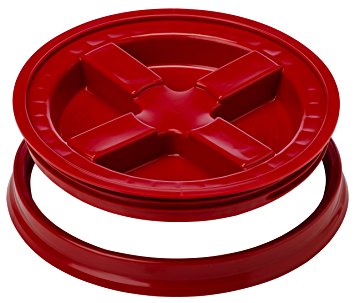
The simplest way to use oxygen absorbers with large amounts of food is to put them into food-grade buckets. You fill the bucket with dry foods, add the right amount of oxygen absorbers, and then close the lid.
The downside is that most buckets will leak air inside. This includes the cheap HDPE 5-gallon food-grade buckets. They slowly leak air, so you could still use them with oxygen absorbers – just not for long-term storage. You are much better off with a gamma-seal lid bucket. These buckets cost more but do create a tight seal.
Also, note once you open the bucket, you will expose the food to air. If you want to reseal the bucket, you’ll have to add more oxygen absorbers.
So, this method isn’t suitable if you plan on rotating through your food stockpile. I’d only recommend using buckets as a short-term solution until you get enough food stockpiled to have a “Mylar bag party.”
Pros
Can easily store large amounts of food
Buckets are durable
4. #10 Cans
Many emergency foods – like butter powder from Augason Farms or Mountain House’s scrambled eggs – are packaged in #10 cans (pronounced ten-pound cans). If you get a can sealer, it’s possible to store your food in these cans at home too.
Using #10 cans for food storage is pretty simple. You just put your dry food in the cans, add oxygen absorbers, and seal the can. The seal is completely airtight, and the cans are tough enough to withstand almost any disaster.
The downside is that the cans and the sealer are pretty expensive. If you are lucky enough to know someone who already has a can sealer you can borrow, you only have to worry about the cans’ costs.
Cons
Cans and sealer are expensive
Only can store small amounts of food per can
How Many Oxygen Absorbers Should I Use?
Oxygen is in the food container in two places:
- In the space between the food
- Inside the actual food
You’ll need to remove virtually ALL of this oxygen to keep the food safe for long-term storage. This means making sure you use enough OAs.
Below is a general guideline of how many oxygen absorbers you will need. However, the amount can vary depending on whether your batch of beans is uniform (lots of air space between the beans) or varying in size (less space between the beans).
You’ll need to do some math to know precisely how many OAs you need. I’ve included the math in the dropdown for those who are interested.
As Fresh Pack points out, there can be a surprising amount of oxygen within certain foods. For example, dry foods like TVP contain a lot of air. The same goes for dry beans.
They also point out that there is incorrect information about how density affects air amount. The idea that “items with small particles (like flour) are ‘dense’ and have less air volume” is FALSE. Here is why:
“A pool filled with marbles will have the same interstitial air volume as one filled with basketballs. Yes, the basketballs will have much larger pockets of air, but there are far fewer of them. Think of a checkerboard with just 2 large black and 2 large white squares… ½ of its area is black and ½ white. What if it had 100 small black squares and 100 small white ones? 1000? Even with tiny squares, it is still ½ black and ½ white as long as they are all uniform.
What does matter is particle size distribution, or in other words, whether you have particles that are all a uniform size or if you have a lot of particles of different sizes. If you have a pool filled with basketballs AND marbles, the marbles can fill in all the large air pockets. So, products with uniform particle sizes will have more interstitial air than products with a greater distribution of particle sizes.”
Calculating How Much Air is in the Container
To figure out how much air will remain between the food spaces in a filled container, you can do this test:
- Put 1 cup of product in a large measuring cup.
- Add 2 cups of water.
- See how many cups you get in total (the amount won’t be 3 cups because the water fills the spaces between the product).
- Calculate: 3 cups – (how many cups total you got)
- The answer is how much of the product was air. For example, let’s say you got 2.5 cups total: 3 cups – 2.5 = 0.5 cups. Since 0.5 = 50%, 50% of the product was air.
With this information, you can do a reasonably exact calculation of how many oxygen absorbers you need. This requires some more math:
- Figure out how much air your container holds. For example, a 1-gallon Mylar bag holds 3785 cubic centimeters (cc’s). A pint jar contains 100cc of air when empty.
- Determine how much air will be left in the bag once filled by product. For example, if you determined that 50% of the product was air, you’d have 1893cc of air space.
- Only about 21% of air is comprised of oxygen (the rest is mostly nitrogen). So, calculate 21% of your air space. For example: 0.21x1893cc= 398cc.
*Some products like beans contain a lot of air inside of them. For the water test to work, you have to let them sit for at least 6 hours, so they absorb the water. Beans also require a lot more oxygen absorbers than typically shown in charts.
| Food Type | 1 quart | 1 gallon | 5 gallon |
|---|---|---|---|
| Beans, lentils, split peas | 125-150cc | 500-600cc | 2500-3000cc |
| Rice | 100cc | 400cc | 2000cc |
| Flour | 100cc | 400cc | 2000cc |
| Instant mixes and powders | 100cc | 400cc | 2000cc |
| Coffee beans | 100cc | 400cc | 2000cc |
| Pasta | 125cc | 625cc | 2500cc |
| Cereal | 125cc | 625cc | 2500cc |
| Instant potatoes | 125cc | 625cc | 2500cc |
| Whole grains (barley, corn, wheat, oats) | 125cc | 625cc | 2500cc |
Top Tip
It is always best to play it safe – use more oxygen absorbers than you think you need! Using extra oxygen absorbers won’t impact the food. OAs are cheap; better to spend an extra 25 cents on an additional oxygen absorber than throw away 5 gallons of food when it’s needed most.
What Foods Can Be Stored with Oxygen Absorbers?
Just about any dry and low-fat food can be stored with oxygen absorbers. This includes foods like:
- Flour
- Whole grains
- Pasta
- Dried beans
- Powdered milk
- Cereal
- Freeze-dried food
- Spices
Note: Not all foods are oxygen sensitive. For example, whole grains, peas, and beans aren’t too oxygen-sensitive. If you plan on using the foods within 5 years, there won’t be too much difference in freshness regardless of whether you use an OA or not.
However, oxygen absorbers do protect against pests and have other benefits, like preserving nutrition. Since OAs are cheap, I recommend using them with all dry foods you want to store for 12+ months.
Dehydrated Food with Oxygen Absorbers
Most home-dehydrated fruits and veggies usually aren’t suitable for long-term storage. They simply contain too much moisture. If the moisture level is too high, you could even risk botulism poisoning (more on that below).
To safely store dehydrated food with OAs, it must be so dry that it snaps when bent. Or, for round foods like corn or peas, it should shatter when pressed with a spoon.
*Read Expert-Level Food Dehydrating
Nuts and Seeds with Oxygen Absorbers
Storing nuts and seeds with oxygen absorbers will extend their shelf life. However, they will eventually become rancid because they contain so much oil.
Most people put the shelf life of nuts/seeds with OAs at about 2 years. However, nuts and seeds can last longer than this, even when exposed to oxygen. The key is keeping the temperature and humidity low.
*Granola also has a lot of oil and won’t store long-term.
Foods that Should NOT Be Stored with Oxygen Absorbers
- Salt: Will become rock hard if stored with an OA
- Sugar: It also will become rock hard; brown sugar also contains too much moisture for storage with OAs. Read how to store sugar for the long term.
- Wet foods: Foods with 35% or more moisture can grow botulism in airless environments. It is recommended that foods stored with OAs have 10% or less moisture to play it safe.
- Baking soda, baking powder, pancake mixes, and yeast: There’s some debate about whether OA can be used with these foods. Some claim that a chemical reaction could occur and result in the leavening products then becoming useless.
Read:
Botulism Risk
Botulism is usually only talked about in regard to home canning. However, because the botulism bacteria grows in no/low oxygen environments, it could also develop in Mylar bags packaged with oxygen absorbers.
Botulism requires moisture of 35% to grow. However, to play it safe, virtually all food preservation guides say that food must have 10% or less moisture to be packaged in airtight containers with oxygen absorbers. (2)
This shouldn’t scare you away from self-storing foods with oxygen absorbers. Ensure you aren’t storing any moist foods in sealed containers with oxygen absorbers.
The good news is that botulism toxin (which causes the disease) can be easily destroyed by boiling it for 10 minutes. The CDC states, “Despite its extreme potency, botulinum toxin is easily destroyed. Heating to an internal temperature of 85°C for at least 5 minutes will decontaminate affected food or drink.” This page also has helpful info on deactivating botulism. Many foods stored for the long-term need to be boiled anyway (dry beans, dry grains, etc.), so this, in theory, would kill any contaminants.
However, that doesn’t mean you should eat any foods which you suspect are contaminated with botulism.
Warning: If the package is bulging (a sign that bacteria or toxins are growing inside), don’t eat its contents!
Shelf Life of Foods with Oxygen Absorbers
Remember that OAs only protect against oxygen. You’ll also want to protect your food against heat, light, and physical damage.
The following table gives a general guideline of what shelf life you can expect when packaging food with oxygen absorbers.
| Food Type | Shelf-Life |
|---|---|
| Hard Whole Grains (Dry corn, buckwheat, soft white wheat, durum wheat, spelt) |
10+ years |
| Soft Whole Grains (Oats, quinoa, rye, barley) | 8+ years |
| Professionally-Dehydrated Vegetables | 10-20 years |
| Professionally-Dehydrated Fruits* | 10-15 years |
| Home-Dehydrated Fruits and Veggies* | 2-5 years |
| Freeze-Dried Fruits and Vegetables | 25 years |
| Legumes (Beans, lentils, chickpeas, split peas) | 25+ years |
| White Rice | 10-30 years |
| Brown Rice | 2-5 years |
| White Flour | 10-15 years |
| Whole-Wheat Flour | 10 years |
| Corn Meal | 5-10 years |
| Potato Flakes | 30 years |
| Pasta | 20-30 years |
| Dry Non-Fat Milk | 15 years |
| Cheese Powder | 10-15 years |
| Powdered Eggs | 5-10 years |
| Nuts | 1-5 years |
| Granola | 1 year |
| TVP | 10-15 years |
*Dehydrated fruits and vegetables must have less than 10% moisture to store with OAs safely. They will snap when bent or (with round food like corn) shatter when pressed with the back of a spoon.
How to Store Unused Oxygen Absorbers
The moment you take oxygen absorbers out of the package, they will start to absorb oxygen. After around 2-4 hours, they’ll have absorbed their maximum oxygen capacity.
You must plan what to do with any unused oxygen absorbers before you begin working. Ideally, you will reseal oxygen absorbers in the packaging they came in. Then you vacuum seal them.
If this isn’t an option, you can also store unused oxygen absorbers in a mason jar. Fill up any extra space in the jar with marbles (or something similar). The less air in the jars, the less air the unused OAs will absorb. Be sure to seal the jar tightly!
How to Tell If Your Oxygen Absorbers Are Still Good
If you buy OAs from a reputable company, they should be good. We like the supplier Wallaby Goods; they are good value and provide high-quality products.
They will arrive in a vacuum-sealed package. Most oxygen absorbers have a “margin for error” added to their abilities. So, they will absorb more than specified.
This is so you can have 10-20 minutes to work with the OAs and not have that air exposure count against you.
Here’s how you can check:
- They arrive in a vacuum-sealed package.
- The oxygen indicator is pink or red and not blue.
- The packets feel soft and not crunchy.
Oxygen Absorbers vs. Desiccants
Oxygen absorbers will absorb oxygen. Desiccants will absorb moisture. OAs require a small amount of moisture for them to activate. Thus, it’s generally not recommended to use both OAs and desiccants together.
There are some exceptions to this rule, though. Some foods (like home-dehydrated fruits) may contain a lot of moisture. Since moisture is one thing that makes food spoil, adding a desiccant can help the food last longer.
In this case, it’s best to use silica gel desiccants because they don’t absorb so much moisture that it will interfere with the OA. Some more advanced types of desiccants can reduce the moisture to practically zero, which means they would stop the OAs from doing their job.
*When using both oxygen absorbers and desiccants, put the desiccant on the bottom of the package and the OA on the top.
Oxygen Absorbers vs. Vacuum Sealing
Oxygen absorbers and vacuum sealing both work by removing air from the packaging. However, vacuum sealing doesn’t remove all the oxygen as OAs do. Also, the vacuum seal bags are not airtight and will slowly leak air into the package over time. Thus, vacuum sealing is NOT suitable for long-term food storage.
There’s also no reason to use oxygen absorbers and vacuum sealing together: OAs do their job well enough without any need to first suck out air. Further, the vacuum sealer will remove nitrogen from the packaging (oxygen absorbers only remove oxygen). If you add an OA to a vacuum-sealed bag, the bag may get so “sucked in” that sharp edges on foods like rice could tear through the bag.
This doesn’t mean that vacuum sealing isn’t suitable for food storage. Vacuum-sealing can increase the shelf life of foods by 3-5 times. It’s also great for storing foods unsuitable for OAs, such as moist foods. But, when you want long-term storage (5+ years), sealed containers with oxygen absorbers are the way to go.
Oxygen Absorbers vs. Gas Purging/Nitrogen Flushing
I’ve recently found many guides and videos about gas purging (aka nitrogen flushing) Mylar bags. The basic idea is to use a special machine to force nitrogen gas into the package. The nitrogen flushes out any oxygen. Then you seal the package, so only nitrogen remains.
Some food manufacturers use nitrogen flushing to keep their greasy foods (such as chips) fresh for a long time. That’s why bags of chips are puffy when you get them.
However, nitrogen flushing is very difficult unless you have access to professional equipment! You must displace all oxygen and ensure none gets back into the bag before you seal it.
Packaging with oxygen absorbers is much easier and leaves just nitrogen in the packaging. Don’t mess with what works – use oxygen absorbers for your home food storage and leave nitrogen flushing to the experts.
[ad_2]
Source link
